
Seismology and the earth
 |
This figure is similar to a frozen version of the animation in the lecture notes. It shows the tracks of the waves with the different zones labeled. The size of the S-wave shadow gives us directly the size of the liquid core. The size of the P-wave shadow and the nature of the P-waves refracted in the liquid core can tell us about the material in this region. The way the P-waves refract on the solid inner core let us study its size and composition, as discussed in detail below. see also http://phoenix.liu.edu/~divenere/notes/earth_int.htm |
Five billion years ago the Earth was formed in a massive conglomeration and bombardment of meteorites and comets. The immense amount of heat energy released by the high-velocity bombardment melted the entire planet, and it is still cooling off today. Denser materials like iron (Fe) from the meteorites sank into the core of the Earth, while lighter silicates (Si), other oxygen (O) compounds, and water from comets rose near the surface.
(J. Louie)
The earth is divided into four main layers: the inner core, outer core, mantle, and
crust. The core is composed mostly of iron (Fe) and is so hot that the outer core
is molten, with about 10% sulfur (S). The inner core is under such extreme pressure
that it remains solid. Most of the Earth's mass is in the mantle, which is composed of
iron (Fe), magnesium (Mg), aluminum (Al), silicon (Si), and oxygen (O) silicate
compounds. At over 1000 degrees C, the mantle is solid but can deform slowly in a plastic
manner. The crust is much thinner than any of the other layers, and is composed of the
least dense calcium (Ca) and sodium (Na) aluminum-silicate minerals. Being relatively
cold, the crust is rocky and brittle, so it can fracture in earthquakes.
How was the Earth's core discovered? Recordings of seismic waves from earthquakes gave
the first clue. Seismic waves will bend and reflect at the interfaces between different
materials, just like the prism below refracts and scatters light waves at its
faces.
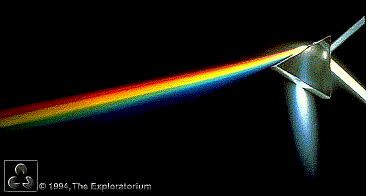
(original
image from the Exploratorium; used by permission)
In addition, the two types of seismic wave behave differently, depending on the material. Compressional P waves will travel and refract through both fluid and solid materials. Shear S waves, however, cannot travel through fluids like air or water. Fluids cannot support the side-to-side particle motion that makes S waves.

(J. Louie)
Seismologists noticed that records from an earthquake made around the world changed
radically once the event was more than a certain distance away, about 105 degrees in terms
of the angle between the earthquake and the seismograph at the center of the earth. After
105 degrees the waves disappeared almost completely, at least until the slow surface
waves would arrive from over the horizon. The area beyond 105 degrees distance forms a
shadow zone. At larger distances, some P waves would arrive, but still no S waves.
The Earth has to have a molten, fluid core to explain the lack of S waves in the shadow
zone, and the bending of P waves to form their shadow zone.
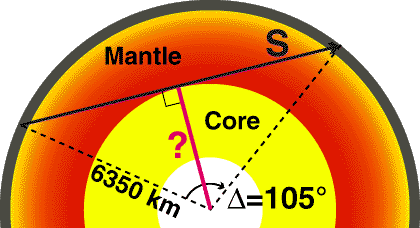
(J. Louie)
You can get a rough estimate of the size of the Earth's core by simply assuming that the
last S wave, before the shadow zone starts at 105 degrees, travels in a straight line.
Knowing that the Earth has a radius of about 6350 km, you have a right triangle where the
cosine of half of 105 degrees equals the radius of the core divided by the radius of the
earth.
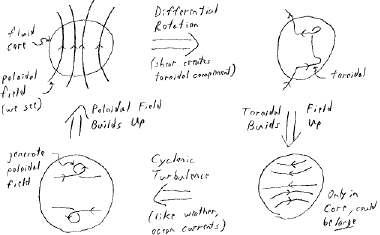
(J. Louie, after a class chalkboard drawing by David Stevenson)
Because the Earth's magnetic field arises in the unstable patterns of fluid flow in the
core, it changes direction at irregular intervals. In recent geologic history it may have
switched direction about every 20,000 years. Any kind of geologic deposit (e.g.: lava
flows, layered muds) put down over time will thus have different layers magnetized in
opposing directions, recording the magnetic field direction as it was when the layer
solidified. Geophysicists can measure the changes in direction to make a magnetostratigraphy
for the deposit.
At oceanic spreading centers new ocean floor is being created constantly and
slowly moved away from the rift. The farther the rock is from the rift, the older it is,
and it will also show the magnetic reversals like a tape recording.
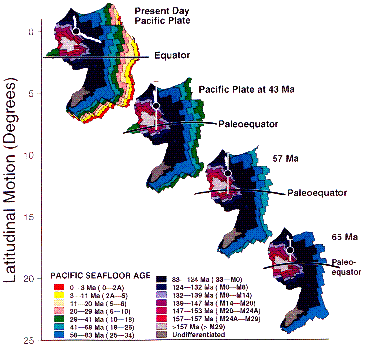
(from Acton and Petronotix, EOS, 1994)
This map of the Pacific Plate at various stages of geologic history could be
constructed from the tape recording. Such maps show how the tectonic
plates have re-arranged themselves over the last 200 million years.
Convection and the release of heat from the Earth's core drives further convection to
release heat from the mantle. Convection in the mantle drives plate tectonic motions of
the sea floor and continents. It is possible to use P waves and S waves traveling through
the mantle from earthquakes to map out this convection, much like a hospital CAT scan can
map out bones and organs with x-rays.

(original image
from the Harvard Univ. Seismology Lab; used by permission)
In this view of a flattened-out mantle from the northwest, the blue blobs show where
colder, denser material is sinking into the mantle. Near the surface, most of the colder
material is in the ancient roots of continental cratons. Subducting slabs of
oceanic lithosphere also appear, being recycled into the mantle from oceanic trenches.
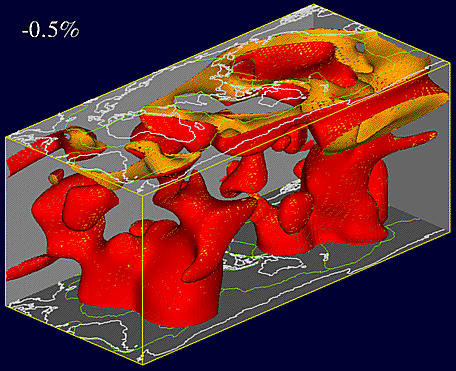
(original image
from the Harvard Univ. Seismology Lab; used by permission)
In this view from the southwest the red blobs are warmer plumes of less dense material,
rising principally into the ocean-ridge spreading centers. A huge plume seems to be
feeding spreading at the East Pacific Rise directly from the core. Most of the heat being
released from the earth's interior emerges at the fast-spreading East Pacific Rise.

(J. Louie)
The part of the mantle near the crust, about 50-100 km down, is especially soft and
plastic, and is called the asthenosphere. The mantle and crust above are cool
enough to be tough and elastic, and are known as the lithosphere. A heavy load on
the crust, like an ice cap, large glacial lake, or mountain range, can bend the
lithosphere down into the asthenosphere, which can flow out of the way. The load will sink
until it is supported by buoyancy. If an ice cap melts or lake dries up due to
climatic changes, or a mountain range erodes away, the lithosphere will buoyantly rise
back up over thousands of years. This is the process of isostatic rebound.
The nearby crust of the Earth can be explored in great detail with echo-sounding
techniques, a kind of acoustic radar. These methods give images in cross section very
similar to hospital sonograms:
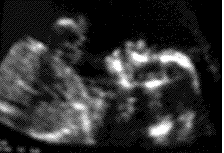
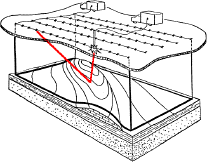
(J. Louie; M. Hewitt, Soc. of Explor.
Geophysicists)
A sonogram in the crust is called a seismic reflection section. Seismic waves from
small explosions or thumper trucks send back echoes from rock layers many kilometers down
that arrays of seismograph instruments can pick up.
Seismic reflection sections can show blocks of the crust in great detail. Individual
layers can be studied for their potential to hold oil, gas, or water; to conduct
contaminants from a dump site; or to describe their geologic origin and history.
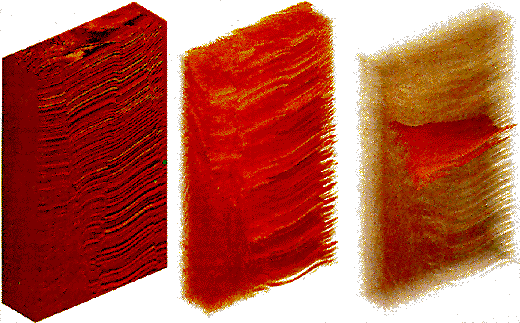
(from Soc. of Explor. Geophysicists, The
Leading Edge, v. 11, no. 11, p. 13; used by permission)
This study of one layer maps out an ancient network of sandy stream channels,
much like the modern channels of the Laramie River, right. Such buried channels can yield
oil or gas easily if seismic reflection work can pinpoint their locations.
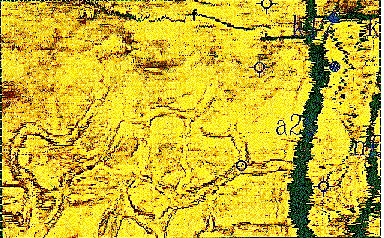
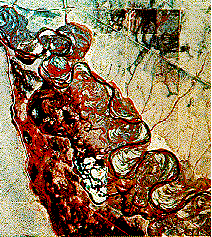
(from Soc. of Explor. Geophysicists, The
Leading Edge, v. 12, no. 6, p. 683; v. 11, no. 8, p. 13; used by permission)
Development geophysicists can build detailed models of complex structures having many
different formations deformed by all types of faults and folds. With these details they
can plan the extraction of oil, gas, coal, or other minerals. They can also predict how ground
water may flow through an area, and find the most efficient strategies to clean up
contamination.
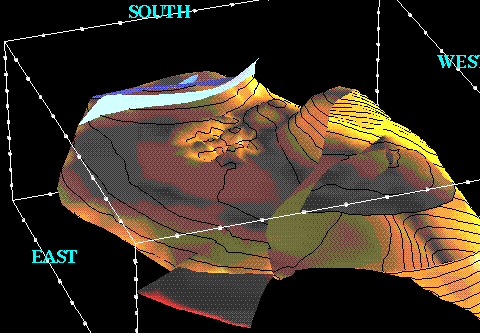
(from Soc. of Explor. Geophysicists, The
Leading Edge, v. 10, no. 8, p. 15; used by permission)
Geophysicists can also make maps of other physical properties that rocks show over an area. Gravitational pull, magnetic field strength, electrical conductivity, radioactivity, and spectral reflectance are all properties that may be used to detect particular rock formations of economic or geologic interest, even if they are buried below the surface.
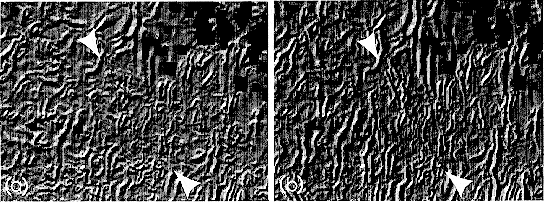
(from Soc. of Explor. Geophysicists, The
Leading Edge, v. 9, no. 9, p. 41; used by permission)
The maps above are derived from maps of magnetic field strength in a part of Nevada.
Computerized artificial illumination from the right direction reveals a subtle lineament
in the image. A buried, slightly magnetized dike could contain gold ores.
Very high-resolution geophysical methods can help geologists wishing to make detailed environmental or engineering studies of rock masses near the surface. Such seismic reflection studies require sources of waves no more powerful than a hammer blow.
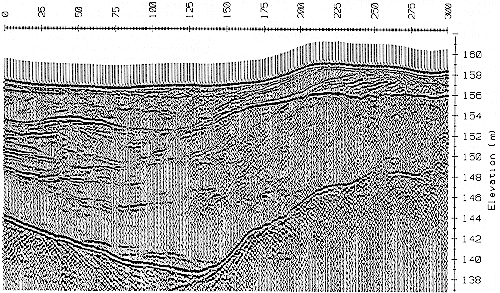
(from Soc. of Explor. Geophysicists, The
Leading Edge, v. 9, no. 9, p. 39; used by permission)
The image above is the output of a ground-probing radar, which is very good at
locating buried pipes, cavities, fractures, and metallic objects. Here it reveals the
detailed structure of a soil layer only 20 m thick, showing channels likely to collect
contaminated ground water.